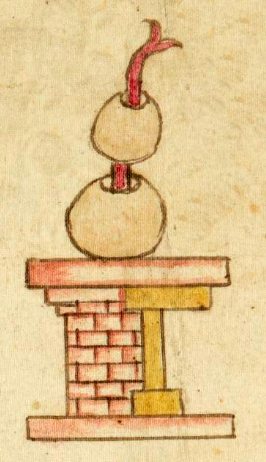Chalca (Azca9)
Chalca (Azca9)
This compound glyph representing the Chalca (i.e., the people of Chalco, sometimes called a calpulli (in this case, an ethnic group associated with migration). The calpulli name glyph can also double as a place name. The glyph features a building (perhaps meant to be a tecpan, or ruling palace) in profile, open to the right, and representing the place, Chalco. The building is clearly made from bricks (probably adobe but given a red color). The platform or foundation and the roof both have white horizontal construction. The T-shaped entrance has yellow or golden beams, probably wooden. The glyphic element on the top of the building is a vertical red leather thong with two jade (chalchihuitl) beads. These beads are a tan color, but they should be a green. The upper tip of the thong is bifurcated, something like a serpent's tongue. The lower bead is somewhat larger than the upper one.
Stephanie Wood
post-1550, possibly from the early seventeenth century
Jeff Haskett-Wood
etnicidades, gente, pueblo de Chalco

chalchihui(tl), jade, https://nahuatl.wired-humanities.org/content/chalchihuitl
-catl, affiliation suffix, https://nahuatl.wired-humanities.org/content/catl
la gente de Chalco
Stephanie Wood
The Codex Azcatitlan is also known as the Histoire mexicaine, [Manuscrit] Mexicain 59–64. It is housed in the Bibliothèque Nationale de France, and hosted on line by the World Digital Library and the Library of Congress.
https://www.loc.gov/resource/gdcwdl.wdl_15280/?sp=9&st=image
The Library of Congress is “unaware of any copyright or other restrictions in the World Digital Library Collection.” But please cite Bibliothèque Nationale de France and this Visual Lexicon of Aztec Hieroglyphs.



